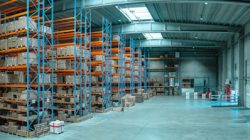Material handling, which is expected to reach a global market value of $127.26 billion by 2025, is a crucial component of logistics and industrial initiatives. This emphasizes how vital logistics solutions are to improving production processes in a variety of industries.
Understanding the intricate relationship between efficient material handling solutions, including advanced lifting equipment, and production efficiency is crucial. It can significantly elevate productivity, streamline operations, and drive your business success.
Key Components of Effective Materials Processing Solutions
Implementing effective materials handling solutions in your business can significantly enhance productivity, streamline operations, and ensure employee safety. Here are the essential components to consider:
- Types of Material Handling Equipment:
- Manual: Ideal for small-scale operations, involving human labor for moving materials.
- Mechanical: Utilizes machines and equipment for handling heavy or bulky materials.
- Automated: Employs advanced technologies like robotics for improved accuracy and speed.
- Safety Equipment: Protecting both equipment and personnel is crucial. Essential safety gear includes guard rails, machine guarding, pedestrian handrails, safety netting, and ladders.
- Key Principles: Effective systems are built on principles such as Planning, Standardization, Ergonomics, and Automation, focusing on optimizing space utilization, enhancing system integration, and minimizing lifecycle costs.
By meticulously planning and integrating these components, businesses can achieve a harmonious materials handling system that boosts efficiency and safety while reducing costs.

Exploring Different Types of Materials Handling Equipment
Examining the wide range of material handling options available to you will show you how much equipment is available to help your company run more smoothly, safely, and efficiently.
- Powered Industrial Trucks & Equipment:
- Forklifts: Capable of handling loads up to 5,000 pounds and reaching heights of 10 to 15 feet.
- Pallet Jacks: Ideal for transporting one to two pallets at a time.
- Order Pickers & Side Loaders: Facilitate elevated picking and narrow aisle navigation.
- Storage & Handling Innovations:
- Automated Storage and Retrieval Systems (AS/RS): Automate the storage and retrieval process, enhancing efficiency.
- Conveyor Belts & Systems: Streamline warehouse operations, with specialized storage racks for optimal space utilization.
- Mezzanines & Platforms: Maximize vertical and floor space in warehouses.

- Engineered Systems & Automation:
- Autonomous Mobile Robots (AMRs) & Automated Guided Vehicles (AGVs): Drive operational efficiencies through automation.
- Custom Conveyor Solutions: Tailored to specific industry needs, facilitating seamless material movement.
- Ergonomic Lifting Devices: Reduce physical strain and injury risk, including vacuum lifters and hoists.
These innovations not only improve efficiency and reduce costs but also contribute to a safer, more sustainable working environment.
Sifting through the available materials handling options
Is a vital tactic for companies looking to improve productivity, security, and flexibility in their operations. Through comprehension of the fundamental elements, investigation of the extensive selection of apparatus, and adoption of technological advancements, enterprises can substantially influence their manufacturing procedures. By optimizing materials handling through strategic selection and rigorous assessment, firms may not only handle present logistical issues but also easily adjust to future development opportunities and demands.
Tags: KS









